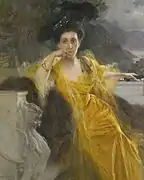François Léopold Flameng | |
|---|---|
 | |
| Born | 6 December 1856 Paris, France |
| Died | 28 February 1923 (aged 66) Paris, France |
| Known for | Painting |
| Spouse | Marguerite Henriette Augusta Turquet |
François Flameng (1856–1923) was a notable French painter during the last quarter of the 19th century and the first quarter of the 20th.[1] He was the son of Léopold Flameng, a celebrated printmaker, and received a first-rate education in his craft.
Work
Flameng initially received renown for his history painting and portraiture, and became a professor at the Academy of Fine Arts. He decorated such important civic buildings as the Sorbonne and the Opera Comique, and also produced advertising work. Flameng was granted France's highest civilian honor, the Legion d'Honneur, and designed France's first bank notes. He was also made an honorary Commander of the Royal Victorian Order in the 1908 Birthday Honours.
Flameng later received renown for his painting of World War I. He was named honorary president of the Society of Military Painters and an accredited documenter for the War Ministry. His work was displayed in the Hôtel des Invalides in Paris, as well as being reproduced in newsmagazines. At the time they were painted, Flameng's war paintings were derided by many critics for being too realistic and not including heroic drama (although his paintings seem romantic to eyes which have seen photographs of genocide and nuclear war).
Most of his war paintings were donated to the Musée de l'Armée in 1920. In 1919 he was elected into the National Academy of Design as an Honorary Corresponding Academician.
Marriage, family and friends

Flameng married Marguerite Henriette Augusta Turquet (1863–?) at Neuilly-sur-Seine on 30 November 1881.[2] Their daughter Marie married the tennis star Max Decugis, whom Flameng also painted.[3]
François Flameng was a friend of John Singer Sargent, who painted his portrait, he also traveled with Jean-Léon Gérôme and Victor Clairin in Italy, and tutored Paul-Émile Bécat.
Gallery
 Reception at Malmaison in 1802 (circa 1894)
Reception at Malmaison in 1802 (circa 1894) Court Ladies Bathing in the 18th Century (1888)
Court Ladies Bathing in the 18th Century (1888) A Machine Gun Company of Chasseurs Alpins in the Barren Winter Landscape of the Vosges
A Machine Gun Company of Chasseurs Alpins in the Barren Winter Landscape of the Vosges Retour d’un vol de nuit sur avions "Voisin" de bombardement (1918)
Retour d’un vol de nuit sur avions "Voisin" de bombardement (1918)_(14779220691).jpg.webp) The pathway of life ... to which is added a biography of Dr. Talmage (1888)
The pathway of life ... to which is added a biography of Dr. Talmage (1888) Le déjeuner de Camille Desmoulins, tableau de François Flameng reproduit dans le Supplément illustré du Petit Journal (5 November 1892).
Le déjeuner de Camille Desmoulins, tableau de François Flameng reproduit dans le Supplément illustré du Petit Journal (5 November 1892). Mme Marie-Louise Fould, née Heine (1903)
Mme Marie-Louise Fould, née Heine (1903).jpg.webp) Portrait of Princess Zinaida N. Yusupova with Two Sons at Arkhangelskoe (1894)
Portrait of Princess Zinaida N. Yusupova with Two Sons at Arkhangelskoe (1894) Frère et Soeurs Brother and Sisters or possibly The Picture Book or possibly Family Portrait of a Boy and his two Sisters admiring a Sketch Book (1900)
Frère et Soeurs Brother and Sisters or possibly The Picture Book or possibly Family Portrait of a Boy and his two Sisters admiring a Sketch Book (1900)
Works
Flameng's portraits include:
- Family Portrait of a Boy and His Two Sisters
- Fashionable Beauty
- Portrait of a Girl Holding Her Two Toy Elephants
- Portrait of Auguste Rodin
- Two portraits of Princess Zinaida Yusupova in Arkhangelskoye
- Portrait of Elsie Salomon Duveen, wife of the art dealer Joseph Duveen, an oval in the Ferens Art Gallery, Kingston-upon-Hull.
- Portrait of Queen Alexandra, consort of King Edward VII, full-length seated, in the White Drawing Room at Buckingham Palace.
Flameng's history paintings included:
- The Carnival, Venice
- Court Ladies Bathing in the 18th century
- Grolier in the House of Aldus (at Grolier Club in New York)
- Molière Demanding an Audience With King Louis XIV at Versailles
- Napoléon Studying Military History
- Reception at Malmaison, 1802
Paintings of the first world war include:
References
- ↑ "Francois Flameng (French, 1856-1923)". www.christies.com. Retrieved 2021-05-14.
- ↑ "Cornélie, Gilberte, Marie FLAMENG". geneanet.org. Archived from the original on 14 October 2013. Retrieved 11 October 2013.
- ↑ Who's who in Europe: dictionnaire biographique des personnalités ... International Publications Service - 1980 "DECUGIS Max Omer. Rentier. Né a Paris, le 24-9-1882. F.: d'Alfred, commissionnaire en fruits et primeurs, et de Sidonie Brauwers. M. : le 16-5-1905, à Paris, avec Marie-Françoise Flameng. Enf. : Christiane. Asc. : François Flameng ...
External links
- The Landscapes of War - page with a gallery of war paintings of François Flameng
- "François, Léopold FLAMENG". geneanet.org. Archived from the original on 14 October 2013. Retrieved 11 October 2013.